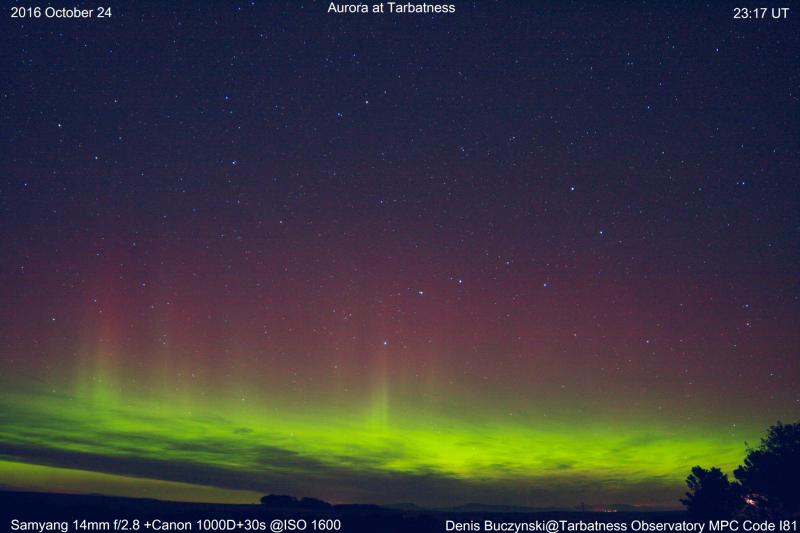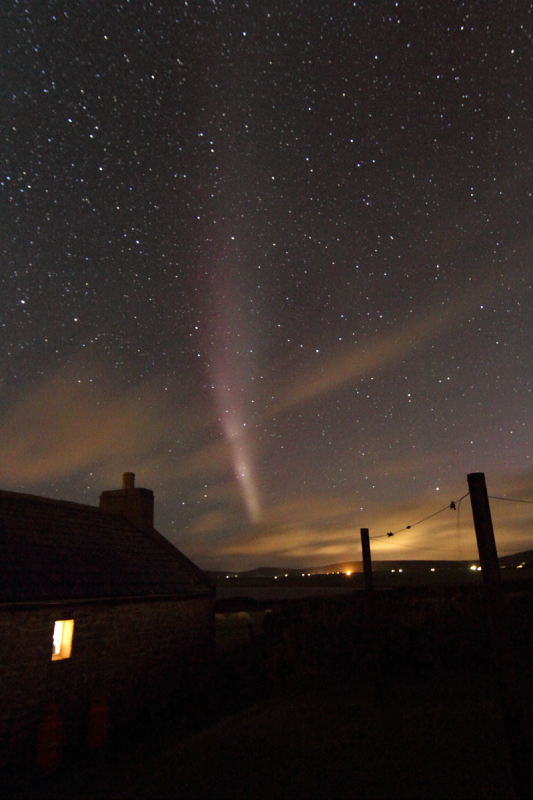2017 March 21
Aurora – a beginners’ guide

Aurorae are produced when highly energetic particles collide with and excite the atoms and molecules of the Earth’s upper-atmosphere. These particles, protons and electrons, are of solar origin and travel via the Earth’s magnetic field to form two permanent rings of auroral light centred around the magnetic poles.
The so-called ‘auroral ovals’, during quiet solar activity, are located at Arctic latitudes – too distant to be seen from the UK. However, following intense solar events and the subsequent enhancement of the solar wind, the auroral ovals, under certain conditions, expand equator wards. It is at such times that auroral displays are seen at temperate latitudes such as the British Isles.
Being so closely linked to solar activity, the aurora reflects the changing nature of the solar cycle. Generally, it can be said that more aurorae will be seen from UK latitudes over the few years around solar maxima. More precisely, the aurora tends to produce two noticeable peaks. The first precedes sunspot maximum by about a year and results from solar flare activity. The second, due to solar coronal hole events, occurs over the early stages of declining solar activity, following sunspot maximum. Strangely, at the actual time of maximum sunspot count, the aurora tends to be infrequently seen.

The aurora can occur at any time during the course of a night. Periodic checks, say, every hour or so, normally suffice and can be combined with other forms of astronomical observing such as variable star or meteor work, for instance. Displays are best seen from dark locations with good, clear northern horizons (auroral activity will always commence from the north). Nights with bright moonlight or twilight conditions are unfavourable. Nonetheless, bright displays can, on occasion, penetrate a moonlit or twilit sky…
Form and Structure
No two auroral displays are ever the same, however, most displays follow a fairly predictable pattern of behaviour, developing easily identified structures in the process.
The following notes describe each of the most commonly seen auroral forms.
| Glow (N) | The first sign of impending auroral activity is normally a faint glow of light lying low on the northern horizon. Auroral glows are similar in appearance to faint twilight conditions, and can easily be mistaken for the light of a distant town or city. However unlike mist you can see stars through it. Also, if any clouds are around, they will be silhouetted by the auroral light from behind. |
| Veil (V) | Bright and active displays can produce a background veil of auroral light covering a large area of sky beyond the main parts of the display. Colours may be seen by the naked eye, normally a pale green. |
| Rayed Arc (RA) | Formation of a rayed arc occurs when vertical columns of light project upwards from a homogeneous arc. Rayed activity often follows sudden brightening of the arc. Again, obvious folds or kinks may be present forming a Rayed Band (RB). Auroral Rays (RR) can also be seen in isolation, stretching up from the horizon in the absence of other obvious activity. This represents the uppermost parts of a display, the remainder of which is being masked by the observer’s horizon and would be much more impressive from a more northerly location. Auroral rays mark the position of the Earth’s magnetic field lines and can extend from 80km up to several hundred kilometres above the Earth’s surface. |
| Patches (P) | Commonly seen during the declining stages of a display are isolated patches of auroral light. Like arcs and bands, patches can be either homogeneous (HP) or rayed (RP). |
| Homogeneous Arc (HA) |
As an auroral storm pushes southward it gradually assumes more definite structures. The homogeneous arc is a rainbow-like arch of light – often green in colour – seen only a few degrees above the north point of the horizon. At times the arc may form twists or kinks, in which case the structure is described as a Homogeneous Band (HB). |
| Corona (C) |
Very occasionally the aurora may push into the southern half of an observer’s sky. When this happens perspective effects cause rayed forms to appear to radiate from a single point close to the zenith. This point represents the magnetic zenith which from UK locations lies 18–25 degrees south of the true zenith. Formation of coronal activity often precedes a decline in activity. Thereafter the aurora will fragment and retreat northward. However, on very rare occasions the aurora can penetrate south of the UK and push over the southern horizon. Recent examples of such unusually intense storms are the displays of 2003 October 29–30–31 and 2003 November 20–21. |
In recent years a new form of Aurora has become visible and is known as STEVE. You can find out more about this phenomenon here.

Sandra Brantingham
Sandra is the Director of the Aurora and Noctilucent Cloud Section of the BAA.
A selection of observations of aurora which BAA members have uploaded to their Member pages.
[Thumbnail image by Paul Curtis]
| The British Astronomical Association supports amateur astronomers around the UK and the rest of the world. Find out more about the BAA or join us. |
